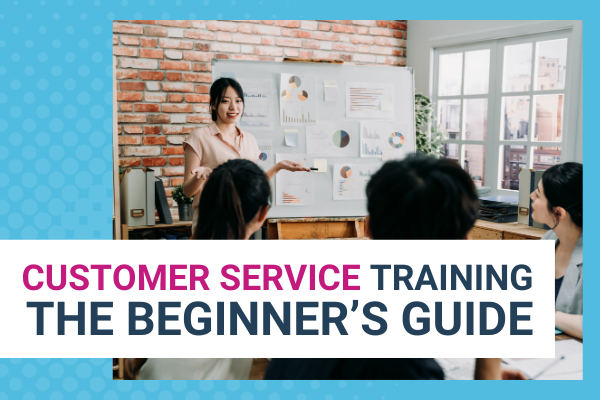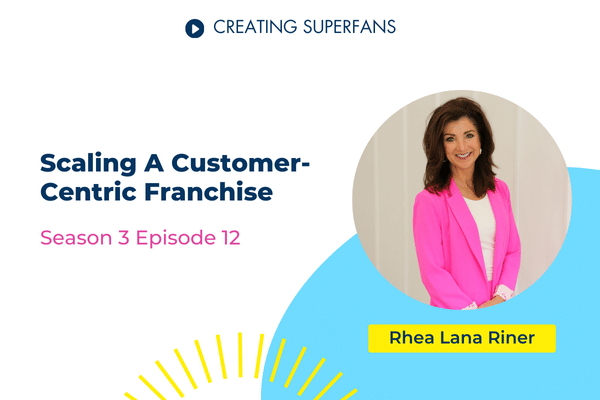Having a strong customer support team is a must, but where do you begin with customer service training? This specific training is the process of upskilling your customer service employees to boost overall customer satisfaction.
While most brands understand the importance of customer service training, they often get it wrong. The biggest mistake is thinking that service training is one-and-done. In reality, this is an ongoing, constant process. There’s no such thing as the ‘perfect’ customer service agent, but you can spend time and resources making sure your team is a great representation of your brand.
Compared to a few decades ago, consumers and businesses have a vastly different relationship nowadays. Previously, customers didn’t care so much about the quality of customer service interactions. Today, the overall customer experience has never been more important. A reported 90% of Americans use customer service as a factor when choosing whether to do business with a company. In other words, it’s a must.
In this guide, we’ll review everything you need to know about customer service training. The right training makes it possible for your team to build strong, long-term relationships with customers. It builds trust in your brand, and it turns average consumers into raving superfans.
What is customer service training?
First, what is customer service training, and how does it differ from other types of training? Each customer service interaction is an opportunity for growth, but it all comes down to the skills of your team. When your customers have a positive support experience, they remember this interaction. It builds trust and authenticity, and this gives you a serious edge over the competition.
In simple terms, customer service training is the coaching of employees in the methods for improving support and satisfaction amongst customers. Through this training, employees are taught the skills and tools needed to serve customers more efficiently.
Moreover, customer service and brand loyalty are two sides of the same coin. Nearly three out of five consumers report that a positive customer service experience is key for them to feel loyal towards a brand long-term. By training your agents in how to handle these interactions intuitively and authentically, you create a strong foundation for the rest of your brand experience.
Why is customer service training important?
Next, why does customer service training matter for your company? We live in a digital age of sharing. This means people are open about the brands they like (and the brands they don’t). A strong customer connection is key if you want positive referrals and word-of-mouth engagement.
When your company excels at customer support, you stand out from the competition. Your customers are the most important part of your brand, so you should invest in the training that keeps every interaction productive. Because you’re training your employees to work directly with these important customers, you want to make sure they have all the tools to succeed.
That being said, don’t make the mistake of thinking customer service exists in a vacuum. Customer service is about the entire organization, not just a few people in a single department. Everyone on your entire team should be trained with the same customer support skills. Every interaction, from marketing to IT, has the potential to influence a customer’s experience.
What are the different types of customer service training?
With that in mind, what are the different types of customer service training? There are three main types of training all employees should have, to some extent. Make sure these are a part of your onboarding and periodic training schedule.
Training for New Team Members
First and foremost, you need to train new members of your team. This sets expectations for employee behavior from the first day. It also lays the groundwork for day-to-day operations and customer interactions.
Start small for new members, giving them a few tasks to incorporate them into the workplace culture. It could also be a good idea to assign a mentor for each new hire to help them hit the ground running. Each new team member should feel confident representing the brand before they begin interacting with customers.
Periodic Training (Quarterly or Annual)
From there, don’t make the mistake of thinking the training is done. Remember, this is an ongoing, continuous process. You’ll need quarterly or annual training to communicate any changes in service policies or practices.
This is also a great time to collect feedback from your team in case any adjustments are needed. Ultimately, use these opportunities to learn how to grow and improve while also providing new guidance. By giving employees a space to share their thoughts and ideas, you also build an open line of communication and trust.
Emergency Training
Lastly, no customer service training would be complete without emergency training. No matter how ‘perfect’ your brand is, mistakes happen. Learning how to own up to these mistakes without playing the blame game is essential. Still, this can be intimidating for employees and managers alike.
This training should be in how to respond to a major mistake, recall, policy change, and so on. In other words, empower your team to stay calm and serve customers during a crisis. Though the best strategy is to avoid problems, it’s always important to prepare just in case. Knowing how to handle a problem when it does happen means you’re proactive, not reactive.
What are the main points of customer service training?
Furthermore, what are the most important parts of customer service training? While this depends on your specific team, industry, and goals, all brands should incorporate the following. Consider these aspects of service to be at the foundation of each and every brand.
Empathy
In many ways, a culture of empathy is the secret to great customer service. Your customers, most of all, just want to feel heard and understood. By encouraging your customer service team to practice empathy, you show you really care.
More importantly, this means your customers are seen as more than just a number on a support page. They’re real people with real concerns, and these concerns matter to your team. Saying, “We understand where you’re coming from and how this experience affected you,” is powerful. Your customer feels heard, valued, and important.
Ways to practice empathy:
- Have your support team run through common customer tasks to understand the customer experience.
- Empathy starts at the top, so be an empathetic leader.
- Review ratings, customer cases, and surveys to explore how customers feel during interactions.
Transparency
Next, transparency is essential. A reported 86% of Americans say they value transparency from businesses more than ever before. How can you keep your customer support interactions transparent? It’s simple: apologize and be upfront.
Nobody likes when brands beat around the bush. It’s always better to say “We take full responsibility” than to pretend it’s not the brand’s fault. There is never a good time to play the blame game. From there, take this as a chance to improve by showing what you’ll do differently in the future.
Ways to practice transparency:
- Share ways for employees to apologize by focusing on emergency training for when things go wrong.
- Use the ‘because’ justifications to always inform customers of the reason behind a decision (“No, that’s not possible.” vs. “Sorry, that’s not possible because…”).
- Communicate with customers during wait times, avoiding uncertainty.
- Encourage feedback from both customers and employees.
Positivity
Additionally, just because you own up to mistakes doesn’t mean you can’t also be positive. Humans are emotional creatures, and customers are only human. They often mirror customer service agent’s emotions and feelings. If a service agent is negative or not sure how to fix a situation, the customer only grows frustrated.
Conversely, by staying positive with each interaction, you evoke the power of positivity. Mistakes will happen, but staying positive about our ability to fix them is a must. An agent saying, “We promise to make things right,” carries a lot of weight.
Ways to practice positivity:
- Use a positive, friendly tone with each interaction.
- Avoid language that shows doubt or negativity (For example, don’t use, “I’m not sure,” “I can’t help you with that,” etc).
- Show gratitude and thank the customer for reaching out to your team.
Composure
When customers get stressed, it doesn’t always bring out their best. We’ve all heard the customer service horror stories from when customers lose their cool. This is why it’s essential for your training to include effective ways for your team to keep their composure.
Firstly, it’s always okay to be human. The customer isn’t always right. Instead, empower employees to take charge in these interactions while keeping calm. The only emotions you can truly control are your own, so composure should be at the heart of every training.
Ways to practice composure:
- Start with understanding to diffuse the situation (“We understand you’re upset, and we’re here to help.”)
- Speak slowly, and avoid taking any comments personally.
- Apologize for failing to meet expectations, but provide justifications for why proper procedures were followed and what steps come next.
- Identify where your employees should establish boundaries in interactions with customers.
Teamwork
Last but not least, teamwork really does make the dream work. Customer service can often feel isolating, especially when it’s so separate from the rest of the company.
In reality, every team member works together to create the overall brand experience. Nobody is in it alone. Through your customer service training, make sure your team knows they’re stronger together.
Ways to practice teamwork:
- Promote open communication between teams.
- Encourage your team to brainstorm together to solve problems.
- Reward your team for providing high-level service.
Free Customer Service Training Resources
To conclude, there are so many great resources for beginning your customer service training. No matter your team size or goals, you can adapt any of these free training resources to meet your needs. Here are our favorite recommendations, trusted by the experts.
Innovative Customer Service Techniques by Lynda.com
Created by Jeff Tolster, president of an award-winning customer service consulting firm, this hour-long course is designed with all teams in mind. Learn what all highly motivated customer support employees have in common, as well as how you can encourage team building throughout your company.
This Lynda course incorporates all of the key points of customer service described above, as well as actionable tips to get started. Most importantly, learn how to transform your team into an elite service provider.
Customer Service Training by ALISON
With a 5-star rating, this Customer Service Training course from Alison is one of the best for beginners. Under 3 hours long, this course shares key customer service skills, as well as tricks to boost customer relationships. Not just for customer support agents, this is a must-take course for anyone who engages with customers in any capacity.
Technical Support Fundamentals by Google
Last but not least, the Technical Support Fundamentals Course from Google is part of the Google IT Support Professionals Certificate. It’s designed with entry-level IT support specialists in mind, but it builds on skills useful for many different tech industries.
Though this is mostly a technical course, it also spends time on the importance of problem-solving. Not only will you learn the basics of IT troubleshooting, but you’ll also learn how to efficiently solve customers’ problems.
Take Your Customer Service Further
Ultimately, you can’t underestimate the power of your brand’s customer service. In today’s world, human experience means everything. Contacting customer support is often the only human interaction customers have, so it’s essential that this gives a positive impression.
If there’s one thing to develop for your brand in 2021, it’s your customer service. If you’re mindful of the role of customer service training in your ongoing efforts, you’re on the right track. These key tips for beginners set a strong foundation, transforming average interactions into a reason for celebration.





